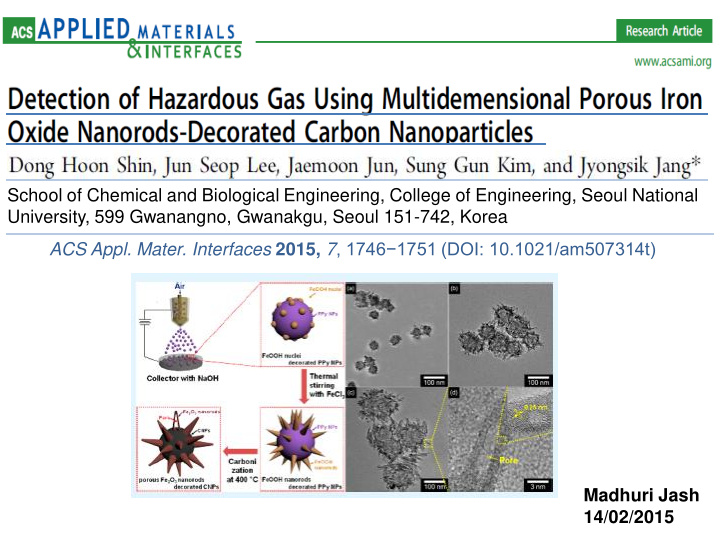



School of Chemical and Biological Engineering, College of Engineering, Seoul National University, 599 Gwanangno, Gwanakgu, Seoul 151-742, Korea ACS Appl. Mater. Interfaces 2015, 7 , 1746−1751 (DOI: 10.1021/am507314t) Madhuri Jash 14/02/2015
Chemical gas sensors have received much attention in the chemical industry for gas leakage prevention. The most recent research has focused on the detection of toxic and harmful gases where NO 2 is among one of them. Over the past several decades the metal oxides nanomaterials have been used for gas sensing, in which Fe 2 O 3 is more promising due to its lower toxicity and high availability. As metal oxide-based sensors require high operating temperature, so they can be replaced by carbon materials due to their room temperature operation with better stability. So much research focuses on carbon nanotubes, graphene, conducting polymers etc. But carbon has a low sensing performance and conducting polymers have a lower mechanical strength, so organic-based iron(III) oxide may be investigated to resolve these issues. In this paper…….. Carbon nanoparticles decorated with multidimensional porous iron oxide (Fe 2 O 3 ) nanorods (MPFCNPs) were fabricated by using a dual-nozzle electros pray, thermal stirring, and heat treatment method. Then MPFCNPs were characterized and their sensing performance as a gas sensor was checked by different methods which show the minimum detectable level is 1 ppm due to the larger surface area of this multidimensional structure.
Fabrication of MPFCNPs : Thermal stirring with FeCl 3 Figure 1. Illustrative diagram of the steps in fabrication of multidimensional porous Fe 2 O 3 carbon nanoparticles Carbonization at 400 ̊ c (MPFCNPs). • The polypyrrole (PPy) NPs are dispersed in an ethanolic FeCl 3 solution and then this solution was electrosprayed in a NaOH solution resulting the formation of FeOOH nuclei decorated PPy NPs. Fe 3+ + 3OH - FeOOH + H 2 O • Then this FeOOH nuclei decorated PPy NPs were stirred in FeCl 3 solution at 70 ̊c to form FeOOH nanorods and finally they were carbonized to form MPFCNPs.
Figure 2.TEM images of MPFCNPs of various sizes: (a) ca. 35, (b) ca. 65, and (c) ca. 100 nm, respectively. (d) High-resolution TEM (HR-TEM) images and lattice fringe (inset) of porous Fe 2 O 3 nanorod. • Here the length of the Fe 2 O 3 nanorods is 12 nm and pore size is 6 nm. • The porous structure is coming due to the decomposition of the OH - group of FeOOH during thermal treatment.
Characterization of MPFCNPs : Figure 3. X-ray diffraction (XRD) analysis. Figure 4. X-ray photoelectron spectroscopy (XPS) of (a) overall scanned spectra and high resolution of (b) C 1s and (c) N 1s of polypyrrole (PPy), CNPs, and MPFCNPs, respectively. (d) Fe 2p of MPFCNPs.
Sensing Performance of the MPFCNPs : Figure 5. BET curve of PPy, CNPs and MPFC NPs with various diamet ers.
Figure 6. Barrett−Joyner−Halenda (BJH) pore -size distribution curve of (a) PPy, (b) CNPs, and (c) MPFCNPs with a diameter of ca. 35 nm. Figure 7. Current−voltage (I−V) curves of various diameter MPFCNPs deposited on an interdigitated array (IDA) electrode. The inset shows field emission-scanning electron microscopy (FESEM) images of the MPFCNPs deposited on the IDA electrode.
Figure 8. Schematic diagram of the NO2 gas sensing mechanism of MPFCNPs. Figure 9. Reversible and reproducible responses at constant current (10 − 6 A) with various sizes of MPFCNPs. Normalized resistance changes upon (a) at different NO 2 gas concentrations (b) periodic exposure to NO 2 gas at 1 ppm at room temperature. (c) Calibration line as a function of concentration of NO 2 gas.
Figure 10. TEM images of (a) CNPs, and (b) short nanorods 35-nm-MPFCNPs (MPFCNPs_35_S) and (c) long nanorods 35-nm-MPFCNPs (MPFCNPs_35_L). Figure 11. Reversible and reproducible responses for CNPs (black), MPFCNPs_35_S (blue), and MPFCNPs_35_L (red), analyzed at a constant current (10−6 A).
Multidimensional porous iron oxide (Fe 2 O 3 ) nanorods decorated carbon nanoparticles were fabricated using dual-nozzle electrospray and thermal stirring, followed by heat treatment. The diameter of the MPFCNPs was controlled by the size of the PPy NPs as the starting material. The as-prepared MPFCNPs were utilized for electrodes for NO 2 gas sensing and it has high sensitivity with decreasing size of the MPFCNPs and increasing length of porous Fe 2 O 3 nanorods. This is highly sensitive, displaying a minimum detectable level of 1 ppm of NO 2 gas, which is lower than the detection level of organic-inorganic hybrid sensors. This is the first fabrication of organic-based metal oxide hybrid materials for hazardous gas sensors, using the dual-nozzle electrospray technique.
FUTURE DIRECTIONS…… We can try with carbon nanoparticles as a starting template instead of PPy nanoparticles. Then we can electrospray any metal oxide on the surface of the carbon nanoparticles.
TH THAN ANK K YO YOU
Recommend
More recommend